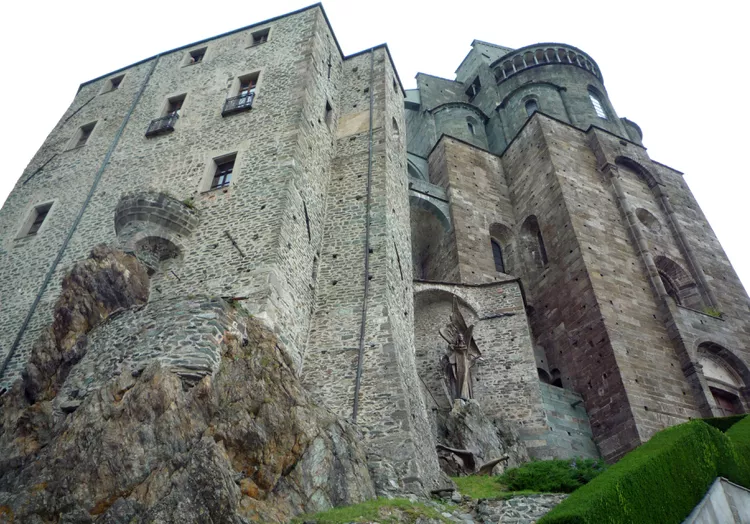Summary
- La Sacra di San Michele, Piemonte
- Montecassino Abbey, South of Rome
- La Verna Sanctuary and Monastic Complex, Tuscany
- Monastery of Santa Croce at Fonte Avellana, Le Marche
- Saint Benedict’s Monastery in Catania, Sicily
- Saint Onofrio Cloister, Rome
- Santa Chiara Monastery Complex, Naples
- Pomposa Abbey, Emilia Romagna
- San Marco Monastery Museum, Florence
- Romanesque Cloister at Torri, Tuscany
Italy has many interesting monasteries and abbeys that can be visited, ranging from evocative ruins to monasteries still in use today where you can take a tour, have lunch, or sometimes even spend the night. They’re often set in beautiful locations. Here are the top ten monasteries to visit in Italy.
La Sacra di San Michele, Piemonte

La Sacra di San Michele, or Saint Michael, is a breathtaking Abbey and monastic complex perched atop a hill in Piemonte’s Susa Valley. Dating back to 983, it emerged as one of Europe’s most recognized Benedictine monasteries from the 11th to 14th centuries. Visitors can see the restored frescoes, the newer monastery buildings from the 12th to 15th centuries, and a museum dedicated to daily life. Notably, this abbey served as inspiration for Umberto Eco’s The Name of the Rose.
Montecassino Abbey, South of Rome

Originally founded in 529 by Saint Benedict, Montecassino is among the oldest monasteries in Europe. It sits atop Monte Cassino, offering spectacular views of the surrounding landscape. The site is also well-known as a significant battlefield in World War II, where the abbey was entirely destroyed during bombings; it has since been lovingly rebuilt. This working monastery welcomes visitors, so plan for a couple of hours to fully explore.
La Verna Sanctuary and Monastic Complex, Tuscany

La Verna is a significant site linked to Saint Francis, known for receiving the stigmata here. In 1216, Saint Francis founded a small church on this stunning promontory, which later evolved into a Franciscan monastery and larger church. Visitors can see the original church, the cave where he slept, and the chapel marking the location where he received the stigmata.
Monastery of Santa Croce at Fonte Avellana, Le Marche

The Benedictine Monastery of Santa Croce, located in Le Marche, offers guided one-hour tours of the monastery (reservations are recommended for English tours). Additionally, you can arrange to enjoy lunch in the monastery. It features a shop selling unique products made by the monks, along with a bar that serves various herbal teas and the monastery’s famous liquor. This monastery, established in 980, is now home to Camaldolese monks.
Saint Benedict’s Monastery in Catania, Sicily

The Monastero di San Benedetto was established in 1334, with the Benedictine sisters relocating to the current site in 1355, built over the ruins of a Roman temple. Highlighted features include excavations of a Roman house within the monastery, the Baroque frescoes in Saint Benedict’s Church, and the 18th-century Parlor of the Cloistered Convent, home to 28 nuns.
Saint Onofrio Cloister, Rome

Saint Onofrio Cloister offers a tranquil atmosphere on Janiculum Hill, dating back to the 15th century. The cloister is adorned with frescos depicting scenes from the life of Onofrio, a hermit. Notably, the Renaissance poet Torquato Tasso lived and passed away in this monastery, with his elaborate tomb located in a chapel on-site. Additionally, there is a museum featuring manuscripts and editions of his works. The monastery continues to be home to the Franciscan Friars of the Atonement.
Santa Chiara Monastery Complex, Naples

Santa Chiara Church and Monastery, constructed in the 14th century, is noted as the largest Clarissan church built. Its stunning majolica tiled columns and benches, along with 17th-century frescoes in the cloister, contribute to a serene ambience, contrasting the vibrant life of Naples. Visitors can explore the archaeological area featuring a Roman bath excavation and view a museum housing religious and archaeological relics, including tombs and items associated with Saint Louis of Toulouse.
Pomposa Abbey, Emilia Romagna

Pomposa Abbey, a significant Benedictine Monastery located near Ferrara dates back to the 9th century. It was once a major cultural hub in northern Italy, known for its remarkable library of manuscripts; notably, the system of musical notation we use today was developed here in the 11th century. Inside the Romanesque Church, you’ll find captivating frescoes and a beautiful mosaic pavement.
San Marco Monastery Museum, Florence
The San Marco Museum is housed within the monastery’s cloisters, famous for its stunning frescoes and notable artworks created by the monk and Renaissance artist, Fra Angelico. It’s also significant as the monastery where Savonarola, the Dominican monk who opposed art and literature, resided; visitors have the opportunity to view his cell. Additionally, the museum showcases other important Renaissance artworks.
Romanesque Cloister at Torri, Tuscany
Located near Siena, the Church of the Holy Trinity at Torri is an off-the-beaten-path destination that sees few visitors, featuring limited open hours. It is rumored to be the only surviving example of a Romanesque cloister in Tuscany. The cloister’s exquisite marble columns, topped with intricately carved capitals, enhance its historical significance. The monastery is first recorded in 1070, later remodeled in the 13th century.
Stay in a Monastery or Convent
Many monasteries and convents offer rooms for overnight guests, usually at affordable prices. While accommodations can be basic and might include shared bathrooms, they are generally clean, secure, and serene, providing a unique experience.





